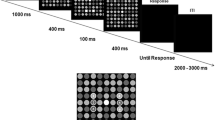Abstract
Change blindness—the inability to detect salient changes when a distractor event occurs simultaneously—has been repeatedly used to investigate the neural correlates of awareness. The fact that the N2pc, which is basically assigned to attention processing, has been observed only for detected changes in such tasks lead to the assumption that this component may also reflect awareness. In contrast to previous electrophysiological studies, we used mudsplashes (experiment 1) or a very short blank (experiment 2) to induce change blindness so that the change was not occluded. A change, regardless of its detection, elicited a reliable N2pc. Successful change detection, however, was reflected in an enhanced amplitude of the N2pc component. Thus, the N2pc cannot be taken as a direct correlate of awareness but rather as a marker for a process that is necessary but not sufficient for awareness. Taking into account the generation of the N2pc in extrastriate visual areas, this finding fits nicely with the recent discussion about reentrant processing as a basis for visual awareness.






Similar content being viewed by others
References
Bar M, Tootell RBH, Schacter DL, Greve DN, Fischl B, Mendola JD, Rosen BR, Dale AM (2001) Cortical mechanisms specific to explicit visual object recognition. Neuron 29:529–535
Bauer H (1984) Regulation of slow brain potentials affects task performance. In: Elbert T, Rockstroh B, Lutzenberger W, Birbaumer N (eds) Self-regulation of the brain and behavior. Springer, Heidelberg
Beck DM, Rees G, Frith CD, Lavie N (2001) Neural correlates of change detection and change blindness. Nat Neurosci 4:645–650
Becker MW, Pashler H, Anstis SM (2000) The role of iconic memory in change-detection tasks. Perception 29:273–286
Block N (1995) On a confusion about a function of consciousness. Behav Brain Sci 18:227–287
Block N (1996) How can we find the neural correlate of consciousness? Trends Neurosci 19:456–459
Brisson B, Jolicoeur P (2007) Electrophysiological evidence of central interference on the control of visual-spatial attention. Psychon Bull Rev 14:126–132
Dell’Acqua R, Sessa P, Jolicoeur P, Robitaille N (2006) Spatial attention freezes during the attention blink. Psychophysiology 43:394–400
Di Lollo V, Enns JT, Rensick RA (2000) Competition for consciousness among visual events: the psychophysics of reentrant visual processes. J Exp Psychol Gen 129:481–507
Eimer M (1996) The N2pc component as an indicator of attentional selectivity. Electroencephalogr Clin Neurophysiol 99:225–234
Eimer M, Mazza V (2005) Neural correlates of conscious change detection. Psychophysiology 42:328–342
Hopf J-M, Luck SJ, Girelli M, Hagner T, Mangun GR, Scheich H, Heinze H-J (2000) Neuronal sources of focused attention in visual search. Cereb Cortex 10:1233–1241
Hopf J-M, Mangun GR (2000) Shifting visual attention in space: an electrophysiological analysis using high spatial resolution mapping. Clin Neurophysiol 111:1241–1257
Hopf JM, Boelmans K, Schoenfeld AM, Heinze HJ, Luck SJ (2002) How does attention attenuate target-distractor interference in vision? Evidence from magnetoencephalographic recordings. Cognitive Brain Res 15:17–29
Hopf JM, Boelmans K, Schoenfeld AM, Luck SJ, Heinze HJ (2004) Attention to features precedes attention to locations in visual search: evidence from electromagnetic brain responses in humans. J Neurosci 24:1822–1832
Huettel SA, Guezeldere G, McCarthy G (2001) Dissociating the neural mechanisms of visual attention in change detection using functional MRI. J Cogn Neurosci 13:1006–1018
Koivisto M, Revonsuo A (2003) An ERP study of change detection, change blindness, and visual awareness. Psychophysiology 40:423–429
Lamme VAF (2003) Why visual attention and awareness are different. Trends Cogn Sci 7:12–18
Landman R, Spekreijse H, Lamme VAF (2003) Large capacity storage of integrated objects before change blindness. Vision Res 43:149–164
Luck SJ, Hillyard SA (1994) Spatial filtering during visual search: evidence from human electrophysiology. J Exp Psychol Hum Percep Perform 20:1000–1014
Niedeggen M, Wichmann P, Stoerig P (2001) Change blindness and time to consciousness. Eur J Neurosci 14:1719–1726
O’Regan JK, Noe A (2001) A sensorimotor account of vision and visual consciousness. Behav Brain Sci 24:939–1031
O’Regan JK, Rensink RA, Clark JJ (1999) Change-blindness as a result of “mudsplashes.” Nature 398:34
Pashler H (1994) Dual-task interference in simple tasks: data and theory. Psychol Bull 116:220–244
Pessoa L, Ungerleider LG (2004) Neural correlates of change detection and change blindness in a working memory task. Cereb Cortex 14:511–520
Posner MI (1994) Attention: the mechanisms of consciousness. Proc Natl Acad Sci USA 91:7398–7403
Rees G (2001) Seeing is not perceiving. Nat Neurosci 4:678–680
Rensink RA, O’Regan JK, Clark JJ (1997) To see or not to see: the need for attention to perceive changes in scenes. Psychol Sci 8:368–373
Simons DJ (2000) Current approaches to change blindness. Vis Cogn 7:1–15
Tong F, Nakayama K, Vaughan JT, Kanwisher N (1998) Binocular rivalry and visual awareness in human extrastriate cortex. Neuron 21:753–759
Turatto M, Angrilli A, Mazza V, Umilta C, Driver J (2002) Looking without seeing the background change: electrophysiological correlates of change detection versus change blindness. Cognition 84:B1–B10
Woodman GF, Luck SJ (1999) Electrophysiological measurement of rapid shifts of attention during visual search. Nature 400:867–869
Woodman GF, Luck SJ (2003a) Dissociations among attention, perception, and awareness during object-substitution masking. Psychol Sci 14:605–611
Woodman GF, Luck SJ (2003b) Serial deployment of attention during visual search. J Exp Psychol Hum Percep Perform 29:121–138
Acknowledgments
This project was carried out at the Max Planck Institute for Human Cognitive and Brain Sciences, Munich, Germany. The authors want to thank Claudia Licklederer who was involved in collecting and analyzing the data.
Author information
Authors and Affiliations
Corresponding author
Rights and permissions
About this article
Cite this article
Schankin, A., Wascher, E. Electrophysiological correlates of stimulus processing in change blindness. Exp Brain Res 183, 95–105 (2007). https://doi.org/10.1007/s00221-007-1023-z
Received:
Accepted:
Published:
Issue Date:
DOI: https://doi.org/10.1007/s00221-007-1023-z




